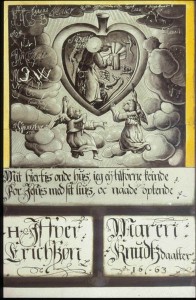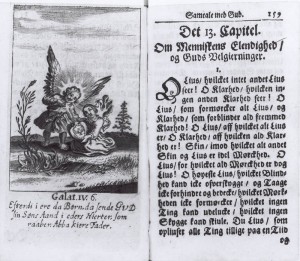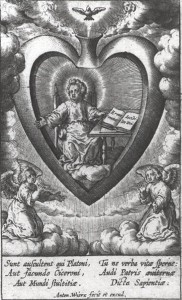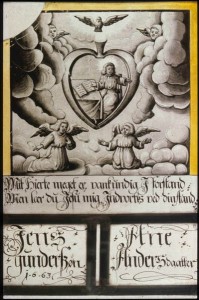Human heart and Sacred Heart: reining in religious individualism. The heart figure in 17th century devotional piety and the emergence of the cult of the Sacred Heart.
by Henrik v. Achen, Bergen
| First published: Amundsen, Arne Bugge & Laugerud, Henning (eds): Categories of Sacredness in Europe, 1500-1800. Conference at the Norwegian Institute in Rome 2001, Universitetet i Oslo 2003, ISBN 82-92298-03-7. |
|
| Web version: 30.03.04 | |
Cor ad cor loquitur
St. Francois de Sales (1567-1622)
Understanding the emergence of the Catholic cult of the Sacred Heart of Jesus in the later part of the seventeenth century, requires an understanding of the figure of the human heart as an important ingredient in early modern piety in Northern Europe. Pictures of human hearts, often direct, literal representations of pious metaphors, became popular religious or devotional images, directly involving the viewer and illustrating fundamental, otherwise invisible, spiritual processes. The devotional interiorization of faith was a main trend in seventeenth century piety, yet not unproblematic in the eyes of organized religion and hence to be dealt with. This short text aims at sketching this aspect of the cult of the Sacred Heart.
Theology of the hearts as a representational phenomenon
By registering, interpreting, combining and systematizing occurrences of the figure of the human heart in all “read, heard and seen” one might inductively try to describe and define the various occurrences of the human heart, collecting them into a theological system complementary to the academic Lutheran theology of the 17th century. This is what my project, so far titled “Theologia Cordis. The Human heart as religious metaphor and symbol”, endeavours. Stressing how much this is a work in progress, and this with still fragile insights, should hardly be necessary. [1]
If such a theology could be constructed, it must have certain characteristics and distinct features, its basic identity revolving around the picture, metaphor [2] or symbol of the human heart – perhaps not quite unlike Luther’s “Theology of the cross”, which has been constructed through a kind of interpretive compilation from his writings. Though constructed in a somewhat similar way the theology of the heart will, however, probably prove to be far more representational in its nature and entire modus operandi.
If, then, the substance of such a theology is expressed both metaphorically, by symbols and by a distinct rhetorical apparatus, this substance may be closely linked to a certain imagery, both literary and pictorial. This is not necessarily a merely iconological phenomenon. Some may be interested in what was conveyed, others in the vehicles of conveying themselves, but from the outset of such an endeavour one might assume that the very distinction between signifier and signified will at least be blurred, perhaps even merge into one. Obviously we may separate the two in trying to recognize the various elements in the construction of such a theology of the heart, but if they are really ingredients of an entity, they must be viewed in a relational perspective which does not separate them. The Theologia Cordis may actually bridge the gap between signifier and signified. Ultimately the fundamental question appears to be whether or not art in itself may be considered a “locus theologicus”, a place where essential things are said “de corde tuo, ad cor tuum”, about your heart, to your heart, to paraphrase the introduction of Flemish Benedict van Haeften in his immensely popular devotional book “Schola Cordis”, published in Antwerp 1629.
So, one might ask if the representational aspects of a devotional theology, “Frömmigkeitstheologie” (Bernt Hamm), in themselves do not guide us towards such a not yet defined theology? If so, this is precisely why an art historian has taken an interest in identifying this pious phenomenon, which seemingly only exists in representations of the human heart, or registered lexicographically according to the appearance of the word in the edificatory literature of that age.
Embarking on such a project one soon encounters a number of areas which need being mapped and discussed. Since the heart played an important role in both Lutheran and Catholic spirituality of the seventeenth century, a devotional theology like the “Theology of the heart” would to some extent be an interdenominational phenomenon, or more precisely: contain various interfacial areas, where on both sides of the border the same vocabularies and pictures were used to express the same interest in the “inner man”, the homo interior. The nature of such interdenominational elements must be discussed. However, also phenomena and developments particular to each confession must be identified, described and explained. This paper deals with only one such phenomenon: the introduction of the Catholic cult of the Sacred Heart of Jesus.
A question of balance between the collective and the individual
At least since the later part of the 12th century saw the introduction of individual piety on a larger scale, and particularly due to the steady rise of the importance of devotion during the Late Middle Ages, religion as a both collective and individual phenomenon became a question of balance: balance between the collective and the individual, between objective revelation and subjective piety, between believing what was to be believed and what one needed to believe, between accepting faith as a given totality (in itself) or choosing from it elements constituting a personal truth (for me). The question of the contemplative life as opposed to the active life was for instance by and large, neither in the monasteries nor in the world a question of pure opposites allocated to either religious or lay people, but mainly of priorities within an over all balance [3] . However, a certain tension between sacramental (objective) and personal (subjective) spirituality did challenge the balance already in the decades before the Reformation, a development obviously enhanced through an increasing literacy leading to the adoption of a more spiritualized understanding of the faith. Recently, in her book on the Virgin Mary in late medieval and early modern thought Donna Ellington has shown that though it affected Protestantism more thoroughly, it transformed Catholic tradition as well [4] – leading to a certain ‘interiorization’ of faith. Thus the transition from oral to literal religious culture had a profound influence on the mental structure of the 16th and 17th centuries, the inward Christianity more easily gaining the upper hand, as it were.
Whenever the individual is granted a larger part in religion, a more important role, or indeed even a role at all, a certain tension between objective ecclesial order and individual pious anarchy is to be expected. If religious individualism is not somehow limited, institutional, which also means collective, religion can hardly survive as a given entity, but risks regressing into personal beliefs with arbitrary common areas. Hence, institutional religion must try to keep together the collective when its under threat or pressure from religious individualism, and this paper endeavours to outline a successful instance of such a defence. It concerns the cult of the Sacred Heart of Jesus, developed in the later half of the seventeenth century. Instead of a complete account of the mental, devotional, theological, or if you wish: confessional landscape of seventeenth century Europe, we focus on the role the human heart came to play, thereby contributing to an understanding of the iconology of the heart figure and thus to an explanation of why, in Catholic Counterreformation spirituality, the Sacred Heart of Jesus was introduced and devotedly promoted, even though Rome for a long time hesitated in making the devotion official.
The interest in the “inner man”
After decades of controversialist theology following the Reformation the need for this particular approach to religion was saturated and the confessional borders more or less established. A certain fatigue towards dogmatics and apologetics seems to have occurred, and though the confessions continued their efforts to consolidate themselves in versatile areas, the next major events would be political or military interventions, not theological. Hence, the new thrust in religious orientation was less dogmatic than spiritual. What people on both sides of the denominational border wanted, was not endless disputes on what Christian truths to believe, but how to live a truly Christian life. A new sense of piety emerged, concerned with what faith meant in each individual life, viewing faith itself as a question of establishing a personal relationship with Jesus. Thus, a new spirituality surfaced, actively seeking to understand and explain faith as a matter for the heart, not the head, interestingly enough indicated in 1584 by a Lutheran triptych actually shaped like a heart, now in the Germanisches Nationalmuseum in Nuremberg [5].
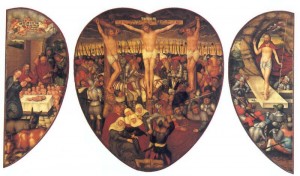
|
| Fig. 1 Triptych, the corpus in a heart shape, from the palace chapel at Wittenberg, painted in 1584 by Lucas Cranach the Yonger. |
Programmatic in its theme and scope was the Catholic series of engravings titled “Cor Iesv amanti sacrvm”, made by the Flemish artist Antonius Wierix 1585-86, and used again and again in the seventeenth century, by both Catholics and Lutherans.
Thus, towards the end of the sixteenth century the religious focus was moved almost literally from head to heart, introducing a new devotional piety within both confessions.
So, the beginning of the seventeenth century saw a new religious interest in “the inner man”, the homo interior, in religion as an inward phenomenon, a question of personal faith. The individual and his or her relation to God gained a new importance. Of course, a new individualism had already been introduced by the Reformation as an essential feature in Protestantism, but the ensuing theological controversy almost buried this individualism under an overwhelming demand for and interest in dogmatics. The early 17th century, however, saw this older trend revived, in Catholicism by a new devotional piety focussing on individual faith as a relationship of love with God, a basic feature of the French School with men like Pierre de Bérulle and Francois de Sales. Typical in this respect is the title of a very popular devotional book by Jean Eudes: “La vie et le royaume de Jésus dans les âmes chrétiennes” published in Caen 1637, running into more than twenty editions before 1700. In Lutheranism a quite similar spirituality was expressed by Johann Arndt in his very popular devotional literature, particularly his “Sechs Bücher vom wahren Christentum”, published in Braunschweig 1606 onwards, and his “Paradiesgärtlein”, which came out in Leipzig in 1612. What mattered was the interior, the heart of the faithful; what did it look like? As early as in 1578 an engraving by the Dutchman Hendrick Goltzius had visualized this question, depicting Christ examining the contents of the human heart like a doctor – an inspection to be imitated by the Christian’s own introspection. [6]
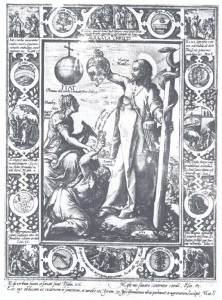
|
| Fig. 4 Engraving from 1578 by Hendrick Goltzius, depicting Christ as a doctor, examining the human heart. |
Important is the fact that now not only Lutheran piety, as could reasonably be expected, but also Catholic devotion aimed at awakening a lay spirituality.
The fundamental Christian question of salvation increased this interest. How could you know yourself saved? While the Roman Church had a number of almost objective measures and the recognized authority to answer this question, the Lutheran “sola fide”, on the other hand, was operationally far more difficult to implement than one would think. In fact, you had no means of knowing. Of course, in principle faith alone would save you, yet did you have a sincere faith and enough of it to guide your way of living, or were you like a whitewashed tomb? A sort of anxious introspection focused still more on the human heart, the only scene of interest in a salvific perspective. Here good and evil fought the battle of which everything depended. Was faith just something to do outwardly, a given set of beliefs and practices, or was it the very core of ones being? So, what did the heart look like? In this we might see a spiritual parallel to the dominating scientific paradigm of that age: analysis, dissection, observation etc.
Hence it is no wonder that the figure of the human heart became so important in the pious literature and pictures of that age. Using it one could describe and depict all really important phenomena: the spiritual processes, the move from damnation to salvation, religious enlightenment, penitence, bliss and so forth. The heart made it possible to visualize the invisible, see the unseen, give body to the spiritual, and do so with dramatic effect. Thus, the heart became a brilliant pedagogic instrument for educating the congregations by depicting, even if rather naively, verbal metaphors which most people understood. The heart, opened like a box, became a theatre of the world, like the English poet John Donne said: “You are a world in yourself”. This was obvious in the Wierix-series mentioned above, or when the heart appeared as done something to, for instance mollified by blows from God’s hammer, as painted on a pulpit from 1670 in Boda church, Värmland in Sweden, copying an emblem from the Lutheran collection titled “Emblemata Sacra”, published in Frankfurt am Main 1624 by Daniel Cramer. The human heart could also be used as a requisite in the interactions between Amor divinus and the Anima humana, as found in van Haeftens “Schola Cordis”, 1629 – or the heart might be replaced by Anima altogether, as in the Herman Hugo’s Jesuit “Pia Desideria” of 1624. The pictures from “Schola Cordis” became very popular even in Lutheran countries.
We find paintings from the decades around 1700 copying the engravings from the book and used in various places in both Denmark, (in the “chapel” at Overgård manor in Jutland) and Norway (on a gallery from Ranes church in Trøndelag). In the 18th century, however, it was Cramer’s heart emblems which were widely used as models for Pietist church interior paintings in both Denmark and Sweden. Such metaphors do not have to be pictorial, they could be purely verbal, “word-paintings” as it were. In the very popular “Paradiesgärtlein”, edited in 1612, Johann Arndt elaborated on such a metaphor: “Let the heavenly seed (meaning the word) bring a hundredfold fruit from the good earth of my heart… Oh, moisten the dry land of my heart with the Divine dew and rain of your Holy Spirit … that your word is pasted to my heart and does not return to you empty, but makes my heart green and flowering in love”….[7]
The human heart in seventeenth century thought
When the Danish scientist Niels Steensen, later a convert to Catholicism and eventually ordained a bishop, in 1664 published his study on the human muscles and glands, he wrote: “The heart has been regarded as the seat of inborn warmth, the throne of the soul, yes, even as the soul itself, the heart has been hailed as the sun, the king, while, if you observe more closely, you will find nothing in it but a muscle”.[8] This scientific insight, however, did not prevent him in 1677 from choosing a heart on which a cross is planted as his episcopal coat of arms. Thus, Steensen testified to the fact that the emerging scientific notion of the human heart actually had very little effect on its symbol value as the core of the personality, the spiritual person, in short: the “inner man”. By and large the human heart was still regarded in such Biblical terms, and not only by theologians. The neo-stoic movement, Justus Lipsius published his handbooks in 1604, saw the heart as the core of the personality, the spiritual centre, where the ability to think was located, and hence the most prominent of human organs. [9] In 1628 William Harvey published his study on the heart and the blood of animals [10] , offering a mechanistic explanation, widely accepted – for all hearts – by the scientific society when he died, though hardly what we would call “common knowledge”. Descartes followed up in his work from 1649 on the relationship between body and spirit, moving the soul from the heart to the brain.
This, however, this did not outdate the heart as a religious symbol, since the nature and function of the human heart within religion had become a matter entirely different from its place in science. As the understanding of the heart as a physical organ and as the core of the entire person ceased to overlap, the emerging symbolic and metaphorical importance of the heart “saved” its continuing religious function, not through scientific observation but through pious introspection. The first now belonged to scientific literature, the second was found in edificatory books. So, the heart, reduced in importance in terms of the entire personality, still remained the place where faith lived or died. Typical in this respect Blaise Pascal in his “Pensées”, written around 1660 as he significantly enough lived at Jansenist Port-Royal, wrote that any insight about God or religion pertained to the heart, not the mind. Thus, the human heart was developed into the religious organ par excellence, quite unaffected by any evolving scientific knowledge of its status as a corporeal organ. [11] In 1681 Jean Eudes’ posthumously published “Coeur admirable de la trés sainte mére du Dieu” went into considerable detail in describing the various aspects of the human heart, stating the heart as a symbol of “tout l’intérieur de l’homme”, the most prominent part of the soul and the place for contemplation. [12]
Towards individualism: The collective and objective under pressure
The ongoing devotional concentration on the inner man obviously led to an internalization and spiritualization of faith. While this aspect was meant as a necessary supplement to outward religion, a complementary phenomenon, and never intended to dispute the legitimacy of official religion and collective expressions of faith, it never the less carried with it a latent tension between the collective and the individual, between objective and the subjective qualities, or if you wish, between dogma and spirit. In both Lutheranism and Catholicism devotional piety seemed to dispose the devout to a spiritual individualism which if not reined in might sooner or later find itself outside the established churches. The balance thus came under pressure and necessarily in some instances orthodoxy carried less weight. Another Goltzius engraving of 1578 visualizes this focus on the individual, as the faithful, instructed by the saviour, copies the Christ Child in her own heart. There is literally spoken little room for any official doctrine. [13]
At times this religious evolution created a gap between religion as a dogmatic, practical and institutional phenomenon and religion as a matter of the heart, creating a personal and intimate relationship between Jesus and the individual, often at the expense of the collective, making at it less apparent why Christians should be interested in the entire apparatus of official religion, when all that mattered was their personal relationship with their Saviour. One might say that “introspection” became more important than ”participation”, with Christ directly teaching every heart, as depicted in a Wierix engraving, later copied in the window from the church at Norddal in Western Norway.
Often these two aspects of religious life converged into a ecclesiastically and dogmatically legitimate spirituality, but not always, and the Protestant individualism was of course more prone to disregarding ecclesial aspects of pious practice, thus having more difficulties in keeping the balance. As Luther himself had stated, the Christian believing the Gospel had received forgiveness, and then true service of God would take place in his heart, because in faith the Holy Spirit was at work in it. [14]
When the condition of the individual heart seemed to gain a de facto priority over the outward apparatus of religion, a theologian like Christian Hoburg (1607-75) almost had to emerge with his strong criticism of the official Lutheran church, instead endorsing a mystical theology, his “Theologia mystica oder geheimen Krafft-Theologia der Alten” published in Amsterdam 1656, attacking both the Lutheran and the Roman Church for being much more concerned with outer phenomena than with the important issue of the inner substance. [15] Similar attitudes are known in Norway from Niels Svendsøn Chronich (1608-after 1658), who, influenced by the mystical spiritualism criticized the outward Christianity of official Lutheranism in his “Åndelig Juule-Betenckning”, Christiania 1644, and “Troens Erindring oc Prøfuelse”, Christiania 1651. In this later year he was, however, condemned and had to leave Norway. The criticism of institutional religion as opposed to true religion never the less remained a latent undercurrent, preparing the way for Pietism. Though Pietism emerged as a legitimate Protestant movement of reform, very soon it came into conflict with secular and ecclesiastic authorities. Particularly the radical Pietism offered strong criticism and separatistic tendencies, seemingly establishing a parallel and more true church concentrating on the interior. We recognize a number of features known from the devotional piety, spiritualism and Pietism in Protestant movements of the 18th century, not least Herrnhutism and in Norway the radical Pietism of a group like the Zionites in the south east, active around 1740.
As the outer traditional apparatus lost its significance as one aspect of the concentration of the inner man, confessional theology itself often appeared less important. As by prominent Protestant agents like Pierre Poiret (1646-1710), publishing his book with the very interesting title of “Hertzenstheologie” in 1690, perhaps the only occurrence of this specific term, and Gerhard Tersteegen (1697-1769) who among other things in 1727 translated the French mystic Jean de Bernieres-Louvigny, Irenism too was a latent risk in the devotional piety concentrating on the heart. Hence vigilantly the religious authorities everywhere observed the phenomenon.
Catholicism too experienced at least two instances where devotional movements developed into illicit phenomena outside legitimate Catholic piety: and Quietism. Characteristically, in their defence they both tried to use the writings of Francois de Sales. [16]
Jansenism found an important source in the writings of Cornelius Jansenius (1585-1635), primarily in his in 1640 posthumously published “Augustinus”. Jansenism was devout and quite sombre, focused and the evil nature of man, the need for repentance and the overwhelming necessity of a redeeming Grace – which hardly could be expected, though. Almost immediately condemned by Urban VIII, the ideas of Jansenius attracted a number of followers, not least in France, most importantly the famous monastery Port-Royal in Paris. After a lengthy examination pope Innocent X in 1653 condemned five sentences, of which two, typical in their ‘interiorization’, might be quoted: “In the state of fallen nature no one ever resists interior grace”, and “to merit, or demerit, in the state of fallen nature we must be free from all external constraint, but not from interior necessity”. Quietism, on the other hand, was developed by Michael de Molinos (1640-96), at least in the strictest sense of the term. From his writings, especially from his “Dux spiritualis”, published in Rome 1675, sixty-eight propositions were extracted and condemned by Innocent XI in 1687. Through annihilating everything the soul annihilates itself returning to God, and this “via interna” leads to a state of being in God, where God dwells in the soul over which no outward authority can exist and where everything is of no importance anyway. Interior souls reject any outward means of piety, resigning themselves in silence to God, nothing else matters. Again, the interiorization of faith and its conflict with ecclesial perspectives is evident. All spirituality has to confront the problem of the relationship between Grace and human nature, and both Jansenists and Quietists lost the religious balance, either exaggerating the role of Grace at the expense of nature, or exalting nature to a degree where Grace was unnecessary. [17] The new Jesuit “Theologia Cordis”, were thus very much dealing with Christian anthropology in a salvific perspective, and to a considerable degree meant as a countermeasure against Jansenism. [18]
A considerable part of the pious edification of that age was concerned with human nature, conversion and being a true Christian, much of it dealing with various aspects of interiority. [19] Hence we understand the popularity and frequent occurrences of the heart as an important religious symbol. In the human heart spiritual processes were made visible and sequences of well known verbal metaphors illustrated the process of conversion and salvation – we recall the Ignacian method of “compositio loci”, which played such a central part in Jesuit guided Counterreformation lay spirituality. Jesus knocked at the door of the human heart, enlightened it exposing its sinfulness, or the heart was hardened in virtue in a real oven or mollified by blows from a divine hammer. Christ and Devil, vices or virtues literally lived and acted in the human heart, and pictures showing this in a straight forward manner were much easier for an average congregation to understand than learned allegories or subtle emblems, as for instance the emblem showing a pair of glasses, introduced by the Riga-edition 1679 of Johann Arndt’s “True Christianity” meaning that nature should be like a pair of glasses to help us see God at work! No, the idea of for instance pious examination of oneself was much easier to understand from a picture showing Jesus walking in the heart with a lamp whose light exposes all sins and vices (Fig. 1), as shown by Wierix in the “Cor Iesv amanti Sacrvm” series, and thus it is hardly surprising that this kind of motif, or like the one with Jesus educating the heart (Fig. 4), became popular as simple didactics. So, the introspective character of seventeenth century piety obviously presented the established churches and theologies with the question of where to draw the line between a legitimate and an illegitimate focus on the ‘inner man’. How little importance could one legitimately attach to the outward man, where was the balance between the internal and the external?
A countermeasure: The Cult of the Sacred heart
To Catholic spirituality excessive individualism with disregard for the magisterium and the both collective and objective quality of the Church was utterly alien. “Le Chrétien interieur”, to quote the title of a book published in Paris 1659 by the Catholic mystic, Jean de Bernieres-Louvigny (1602-59), was inseparable from the practicing ‘outward’ Catholic. When the spiritual development towards individualism and concentrating of each individual heart threatened to destroy the balance, the Church had to find countermeasures. As part of Catholic erudition official condemnations were necessary and important enough, but one needed a new, popular and controlled devotion to discipline devotional excesses. In a spiritually engaged century the Church could not only condemn, which would be the outward religion suppressing the inward faith, but had to move from within piety itself to find a devotion, which could be used to rein in individualism, not by outward disciplinary measures, but by replacing it, using the existing interest in interior phenomena and much of the same words and imagery. The pious individualism should be stopped and turned on its own premises; thus the cult of the Sacred Heart of Jesus emerged, contributing to the forming of a collective denominationally specific mentality, to work against the crumbling of confessional identity by creating an integrated Catholic environment centred on and bound together by such a cult. [20]
In the late Middle Ages the human heart had begun to occur in connection with secular love, around 1470 magnificently demonstrated by the quite famous woodcut of one Meister Caspar with its pictorial rendering of love metaphors. In religious context too the heart of Jesus was depicted, then always as a passion symbol, mostly carrying the side wound. The human heart too occurred as a kind of attribute of the devout. Considering how the renewed devotional spirituality of the seventeenth century depended on its late medieval roots – again on both sides of the confessional border – it is hardly surprising to observe the heart imagery returning. Thus a great similarity is to be found between such representations as respectively St. Catherine and St. Marguerite Marie Alacoque changing hearts with Jesus, both kneeling in front of an altar offering their heart to Jesus, or a motif like the Christian dwelling in the heart of the Crucified Saviour, or of the opposite: Christ entering the human heart. [21] The new individualism of the Reformation likewise contributed to the reoccurrence of this iconography. One quite fundamental concept, the necessity for the human heart to imitate the heart of Jesus, was known from the Lutheran devotional piety of a Johann Arndt too: “Ach mein lieber Herr / gib mir ein ander Hertz / ein newes Christliches Hertz / das deinem Hertzen gleichförmig sey”…, he wrote in “Paradiesgärtlein”. [22] However, one should be careful not to suggest a too straight forward continuity, as the interest of the 17th century in the human heart, and in the heart of Jesus, indeed established a new and important feature in European thought – and iconography.
If the cult of the Sacred Heart should be able to discipline the existing individual piety, not merely reintroducing a late medieval passion symbol, an almost new quality had to be introduced in a hitherto unprecedented explicit way, namely the very interacting between the Sacred and the human heart. [23]A small Flemish devotional image with a short prayer, engraved by Michiel Bunel in the first half of the 17th century, demonstrates this very well. The Sacred Heart is depicted with the side wound and with a cross planted on top and surrounded by the crown of thorns, thus obviously a passion symbol of late medieval character.
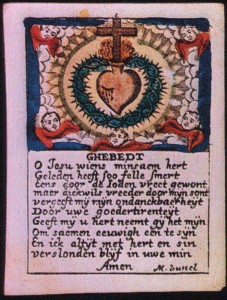
|
| Fig. 8 Small pious card, handcoloured engraving by Michiel Bunel with Dutch prayer below, first half of the 17th century. |
Below, the printed prayer reads: “O Jesus, your loving heart has suffered so much pain … Give me your heart and take mine, that we may stay together in all eternity, my heart and mind always consumed by your love”. [24]Though the initiative belongs to Jesus, we observe a typical reciprocity here, which Francois de Sales had already mentioned, stating that love was not just caused by likeness, as Thomas Aquinas had seen it, but by a relational quality, a “correspondance” as it were, between the loving and the loved. [25]This might be what Eudes meant by the expression “l’intériorité mutuelle de l’amour” in “Coeur admirable”, 1681. The double movement, love from God Incarnate to the devout who answers by loving back came to be the very substance of the devotion to the Sacred Heart.
But firstly the Sacred Heart had to be introduced as an important devotional symbol – and hence its depiction a devotional object. [26] Jean Eudes (1601-80) was the one to aim directly at the heart of Jesus. Focusing on the personal, loving relationship between the faithful and Jesus Christ as the core of Christianity, following the tradition of Francois de Sales, Eudes used the word “heart” to express all things concerning this relationship. However, in a Catholic perspective this interest in the individual human heart had to be combined with an understanding of the all important collective and the objective qualities of the Church. Thus the human heart had to have a focus outside itself, namely the heart of Jesus, which would then on the other hand change the human heart into an image of itself. The individualism had to be measured against – and controlled by – something which could and should be described and defined dogmatically: Jesus Christ. This fits nicely into a view of the entire French School as characterized by a clear christo-centric quality. [27]
This relation between human and Sacred Heart meant that the evaluation of the human heart depended on the degree of likeness of the Sacred Heart, which practically moved the entire set of criteria into the Christology of the Church, the subjective thus held in check by the objective, the individual by the faith of the collective. The focus of the devotion to the Sacred Heart of Jesus remained outside the individual, while the human heart through its devotion should be changed into the likeness of the Divine heart itself. Praying for the love of God, St. Eudes bursts out: “Oh, Divine love, be the Life of my life, the Soul of my soul, the Heart of my heart, as I do not live but in you and by you”… [28] By introducing a pure symbol conveying the core of Jesus in a devotional perspective, and by stressing the reciprocity between the individual heart and the Sacred Heart as the goal of any legitimate Christian piety (an aspect of late medieval “imitatio Christi”) the entire set of implications of the Christology of the Church became the very yardstick by which any individual perspectives and devotions were to be measured.
So, when you introspectively examined your heart, you should not only find Jesus in it instead of the devil, but you should find a perfect reflection of the heart of Jesus. This, however, in effect moved the focus from the interior to the exterior, from yourself and your spirituality to Jesus Christ as he appears according to the Church. Now the heart of Mary immediately became of great interest, since she was the perfect reflection of her son, having kept all his words in her heart. Thus, in accordance with a general tendency in the French School as such, an iconography of the heart of Virgin Mary was introduced, replacing the heart of the ordinary believer, as so often in Catholic piety offering the mode of “imitatio Christi” as an “imitatio Mariae” or “imitatio sanctorum”. [29] Her role as model for Christians and their link to her son was traditional and could thus be activated within this devotion. Between the hearts of Mary and Jesus complete correspondence existed, and the hearts of Mary and Jesus often appeared together. As early as in 1648 Eudes had published his first treaty on Mary, focusing on her holy heart. Through the heart of Mary the human heart received its human role model on how to imitate Christ, an imitation which had formed an important part of the early heart symbolism, as it appears in a Bolswert engraving in Suquets “Via vitae aeternae” published in Antwerp 1625. Mary was nothing, had nothing and could do nothing but through her son who was everything in her, Eudes had written back in 1637 in “La Vie le Royaume de Jésus”. To what degree the hearts of Jesus and Mary overlapped, and to what extent the individual and the entire Church was understood as partaking in one Sacred Heart, is clearly demonstrated by Eudes, when he talks about a rosary to the sacred love of Jesus: “It must be understood that the heart of Jesus and the heart of the holy Virgin and all the hearts of the angels and of the saints in heaven and on earth, all those hearts together are but one single heart with the most holy heart of Jesus and Mary, by the union existing between all those hearts, and that heart is our heart”… [30]So, the individual human heart is not the measure, but, to the extent it has taken the likeness of the heart of Jesus, every human heart is incorporated into the unity of what really matters, namely the Sacred Heart of Christ expressed as a community of love, which is the Church.
These aspects of the Mariology obviously owed a lot to the necessity of addressing Protestant objections, the new cult to be understanding anthropology and Mariology in a christo-centric perspective. When Jean Eudes’ liturgy to the Sacred Heart of Jesus was approved, in 1670, and celebrated from 1672, though in a quite limited way, the ecclesial dimension of this new phenomenon was made clear.
It must be remembered that all this happened before the nun Marguerite-Marie Alacoque (1647-1690) had her visions, where, in June 1675, Jesus showed her his heart, afflicted by the crown of thorns and with a cross on top, wishing that a specific cult should be established serving as atonement for the hurt and irreverence Christ had endured through centuries dwelling in the tabernackles on the altars of the Church. So, the new cult had obvious elements of passional piety, and clearly of penance too, the devotion concentrating on the concept of the suffering but loving heart of Jesus, as we find it in many popular devotional images of those decades. While St. Eudes remained somewhat elitist in his devotion, it was the cult in its simple visual and anthropocentric Alacoquian approach which was to become truly popular, and therefore receptionally the more important. As early as in 1698 a large painting of Alacoque having her vision was to be placed in the church of the Jesuit College at Augsburg. [31] One of the earliest examples of the iconography of the Sacred Heart in a prominent place might actually be in Rome, in Ss. Trinità dei Monti, where the monastic seclusion is secured by a wrought-iron grate from the year 1679, running across the nave. Above the gate in the middle a big, sculptured, brass Sacred Heart is placed, carrying the crown of thorns and with protruding flames and radiance. Significantly enough, the church belonged to the French kings. A new spirituality and a new spiritual iconography was thus already established on a traditional level, the heart no longer human and part of an emblematic ensemble, no longer so much belonging to a kind of pious “historia”, but evolving into a cultic object in itself; the Sacred Heart of Jesus emerging as an “imago”. [32] From c.1740, the classic representation was to be found in the northern side chapel of Il Gésu in Rome, in the famous and extremely often copied painting of Pompeo Batoni, with Christ offering and showing His heart to the spectator.
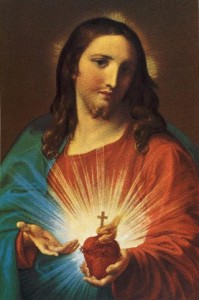
|
| Fig. 9 Pompeo Batoni: Sacro cuore di Jesù, painting on the altar in the northern side chapel of Il Gesù in Rome, ca. 1740. Photo: Il Gesù, Roma. |
By and large the contents of this spirituality was everything Jesus was taught the faithful to be, concentrating on redemption due to what we might call “Jesus Christ, man and God, testifying to the divine passion of love for mankind”. The main substance of the devotion was no more subjectively spiritual but objective and Christological – an area falling under the authority of the Magisterium. Hence Batoni painted not just the symbol, but the figure of Christ Himself offering His heart to the spectator.
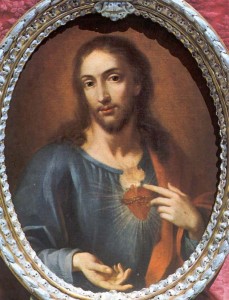
|
| Fig. 10 The sacred heart (Herz-Jesu), painting by Josef hauber 1775, in the Jesuit church St. Michael's in Munich. |
As a disciplinary measure on the terms of current devotional piety itself, summarizing the main thrust of the spirituality of the French school, the new cult was most effective. [33] Typically Eudes had from the start engaged himself in the restoration of the Church in France, a work interesting the Propaganda Fide in Rome, and the liturgy to the Sacred Heart of Jesus was a continuation of this work. The Jansenists hated it, of course. Most interestingly, after Alacoque the cult was as enthusiastically promoted by the Jesuits as it was met with resistance and disinterest in Rome. The Jesuit father Claude de la Colombière was very important for the spreading of the cult which suited and was partly composed by Ignacian spirituality in its optimistic anthropocentric and dramatic-visualizing quality. [34] In 1691 the Jesuit Jean Croiset in Lyon published “La Dévotion au Sacré Coeur de N.S. Jesus-Christ”, and soon the cult was a practiced fact, not only in the convent of the deceased Marguerite-Marie, but by the people. [35] Yet, in 1704, one of numerous editions was placed on the Index, probably due to formalities, but actually remaining there until 1887. However, as a popular cult the Sacred Heart had a tremendous success, more than 700 Sacred Heart confraternities being founded by papal brief before 1740. As the Jansenist threat diminished during the later part of the 18th century, it was precisely this popularity which carried the cult further, when the Jesuits had no more use for this weapon against heresy.
Still the cult had to conquer Rome liturgically as it were, and it didn’t happen until 1765 as the liturgy of the Sacred Heart was approved for the Polish dioceses, and soon for many more [36] The reason for the hesitant Roman recognition was probably that the Jesuits had their experience from the trenches, knowing the state of affairs in northern Europe, and knowing which tactical means were needed, while Rome never quite understood the situation in the north, and – due to its innate conservatism concerning such matters – found no compelling reason to make a popular cult official, no reason to mix private devotion with ecclesial worship. So, for a very long time the cult basically remained a popular devotion, contrary to the earlier devotion which until Alacoque primarily had been a clerical or monastic exercise, but now seemed particularly appealing to lay people. [37] Not until 1856 Rome officially and generally recognized the importance of the symbolism of this devotion. Being what we might define as a “symbolic devotion”, the symbol, the heart, occupied center stage, and hence the pictorial or visual aspects of the cult were particularly important. [38]
The Catholic devotion to the Heart of Jesus was not without reflections in devout Pietist circles where the concept of the heart of Jesus was not unknown, perhaps most clearly in Herrnhutism, where the pleura-cult though rather extreme, never the less seems somewhat related to the contemporary Catholic devotion to the Sacred Heart. A Herrnhut expression like “crawling into the side wound of the Saviour” could actually be found depicted in Catholic devotional images.
Conclusion
The cult to the Sacred Heart of Jesus became a tactical instrument developed to deal with a current devotional trend marked by a tendency to focus on the individual, thus building up a tension between the collective and the individual, between personal faith and ecclesial teachings. By keeping its popular symbolism but changing the focus of this devotion, it saved the Theology of the heart as a legitimate Catholic devotion by concentrating it on “le coeur de mon coeur”, Jesus Christ. Through the devotion to the Sacred Heart it became possible to rein in the latent excessive individualism promoted by the current devotional concentration on the human heart, but doing so from within piety itself, and not as an outwardly disciplinary manoeuvre. In this way a change of the Theology of the heart took place in Catholicism, a new direction, indeed, but deeply rooted in the entire prehistory and vocabulary of this spirituality, keeping Counterreformation piety from individualistic excesses without giving up the heart as a prominent religious symbol and metaphor. The cult of the Sacred Heart summed up the interest of an entire century and gave it a legitimate Catholic answer which ensured that religion remained within the confessional collective, in short: within the Church.
Following the controversialist theology of the later part of the sixteenth century we might within Catholicism and Protestantism observe converging devotional movements, which for a period overlapped in large areas, then parted again, the Protestants moving towards Pietism and eventually a devotional life at the periphery of the Lutheran churches, the Catholics focusing on the Sacred Heart and a traditional popular piety by and large expressed by practices within the Church itself. To return to our point of departure, this possible devotional “Theology of the heart” with its obvious interdenominational features seems to have been situated in what we might call “zones of contact”, meaning Northern Europe, in the roughly seventy years where the devotions of these two denominations more or less overlapped.
* * *
Achen, Achen v: ”Det indvortis menniske. Barokkens hjertesymbolikk i glassmaleriene fra Norddal kirke”, in: I balansepunktet, Sunnmøres eldste historie, ca. 800-1660, S.U. Larsen og J. Sulebust ed., Ålesund 1994, pp. 420-430.
Achen, Achen v: ”Menneskehjertet som sjelens sete. Barokkens hjertesymbolikk og hjerteteologi”, in: Onsdagskvelder i Bryggens Museum XII, A. Ågotnes ed., Bryggens museum, Bergen 1997, pp. 64-82.
Achen, Henrik von: ”Kampen mellom godt og ondt. Om menneskehjertet på 1600-tallet”, in: Kontinuitet og konfesjonalitet, Harry Fett Minneseminar, 8. okt. 2000, Bente Lavold ed., UiO, Oslo 2001, pp. 53-58.
Aumann, Jordan: “Christian Spirituality in the Catholic Tradition”, (1985) 6th impr. London 2001.
Blee, Francis John: “The Heart of Christ as Symbol: A psychological and Theological Study of its Implications and Relevance”, (N.Y. 1993) Ann Arbor, Michigan 1996.
Busch, Norbert: “Katholische Frömmigkeit und Moderne. Die Sozial- und Mentalitätsgeschichte des Herz-Jesu-Kultes in Deutschland zwischen Kulturkampf und Erstem Weltkrieg“, Gütersloh 1997.
Campbell, ted A: “The Religion of the Heart”, University of South Carolina Press 1991.
Eudes, Jean: Le Cœur admirable de la Très Sacrée Mère de Dieu, I-XI, in: Oeuvre complétes du vénèrable Jean Eudes, ed. Joseph Dauphin and Charles Lebrun, vol. VI-VII, Paris 1908.
Eudes, Jean: “La dévotion… au Très saint Coeur… de la… Vierge Marie”, Autun 1648, in: ibid. Vol. VIII, Paris 1908.
Haeften, Benedict van: „Schola Cordis“, Antwerpen 1629.
Königbauer, Ludwig: „Das Menschenbild bei Franz von Sales“, Regensburg 1955.
Nørager, Troels: „Hjerte og psyke. Studier i den religiøse oplevelsens metapsykologi og diskurs“, København 1996.
O’Donnell, Timothy T: „Heart of the Redeemer“, (1989), repr. San Francisco 1992.
Schmidt, Martin: “Wiedergeburt und neuer Mensch”, Arbeiten zur Geschichte des
Pietismus, Bd. 2, ed. Aland, Peschke, Schmidt, Luther-Verlag Witten 1969.
Spamer, Adolf: „Das kleine Andachtsbild von XIV. bis zum XX. Jahrhundert München 1930“.
| [1] | I have dealt with the subject in some short preliminary texts, see Achen 1994, 1997 and 2001. |
| [2] | In 1996 the dissertation of Nørager was published, dealing with both metaphors, the language of the heart and a number of theological-anthropological implications. As with Blee 1996, he used mainly a psychological perspective. |
| [3] | The first hymn to the Sacred Heart, “Summi Regis Cor” occurred at that time, made by the Premonstratensian Hermann Joseph (1150-1241), see O’Donnell 1992, pp. 95seq. |
| [4] | Ellington 2001, p. 19seq. |
| [5] | The corpus with a representation of the Crucifixion is shaped like a heart, and hence each wing forms one half of a heart, respectively rendering the Nativity and the Resurrection. The triptych was painted by Lucas Cranach the younger (1515-86). |
| [6] | See Walter L. Strauss ed.: Hendrik Goltzius 1558-1617. The Complete Engravings and Woodcuts, I-II, New York 1977, nr. 25, I p. 70seq. |
| [7] | Quoted from an edition of Nürnberg 1642, p. 63seq.: “Lass diesen himmlischen Samen auff dem guten Acker meines hertzens hundertfältige Früchte bringen … Ach befeuchte die dürre Eidreich meines Hertzens mit dem Göttlichen Thawen und regen deines heiligen Geistes … dass dein Wort in meinem hertzen bekleibe vnd nit leer wieder zu dir kom / sond’n mein Hertz grünend vnd blühend mache in der Leibe“ … |
| [8] | Nicolai Stenonius: ”De musculis et glandulis observationum specimen”, Amsterdam-København 1664. |
| [9] | See Mark Morford: «Stoics and neostoics. Rubens and the Circle of Lipsius», Princeton New Jersey, 1991. |
| [10] | William Harvey: «Exercitatio anatomica de motu cordis et sanguinis in animalibus», Frankfurt am Main 1628. |
| [11] | An important reason, though, why Rome hesitated in approving of the Cult of the Sacred heart was to avoid taking part in the ongoing scientific discussion of the status of the human heart as an organ, since the prime spokesman of the cult, Fr. Gallifflet SJ, in 1726 had stated the physical heart as the seat of emotions and love, see O’Donnell 1992, p. 147seq. |
| [12] | In his Hertzens-Theologie, Poiret wrote: «Das Hertz und die Seele bedeuten in der geheimen GOttes=Gelahrtheit einerley», Poiret 1702, p. 3, which was what Benedict van Haeften had written two generations earlier: Schola Cordis: «Cor ipsam Animam significat», the heart signifies the soul itself, van Haeften 1629, p. 11. To Norbert Busch the religious interest in the heart was due to its general popularity, while one might argue that the general interest stemmed from its religious and spiritual importance, see Busch 1997 p. 47. |
| [13] | Strauss 1977 op. cit., nr. 26, I, p. 72seq. See also nr. 54, ibid. p. 124seq. A related motif is found as early as in 1550, where the devil is depicted painting vices on a human heart, an engraving by Dirck Volkertsz Coornhert, see Jeffrey Hamburger: The Visual and the Visionary, New York 1998, fig. 8.2, p. 399. |
| [14] | Luther’s works. Critical edition, Weimarer-Ausgabe (WA), WA I. Abt., Vol. 41, p. 152, 2. sermon on psalm 110, given on the 10th May 1535: „da folget denn hernach rechter Gottes dienst jnwendig aus dem hertzen, Denn bey solchem glauben wircket der heilig geist im hertzen“. |
| [15] | Martin Schmidt1969, pp. 51seq. |
| [16] | Aumann 2001, p. 216. |
| [17] | Ibid. pp. 228seq. |
| [18] | Busch 1997 pp. 54seq. |
| [19] | See Campbell 1991 in general. |
| [20] | Busch 1997 p. 24. |
| [21] | Guidoccio Cozzarelli (1450-1517), St. Catharina offering her heart to Jesus, painting in the Pinacoteca Nazionale in Siena, and the traditional eighteenth century rendering of St. Marguerite Marie Alacoque offering her heart to the Saviour. The later motif in a 14th century manuscript in Staatsbibliothek Berlin, Preussischer Kulturbesitz, ms. 417, see Jeffrey Hamburger: Nuns as Artists. The Visual Culture of a Medieval Convent, Berkeley, Los Angeles and London 1997, plate 10. and in small 18th century Flemish devotional pictures, for an example, see the Catalogue “Das kleine Andachtsbild”, Straelen 1982, Cat.no. 37, p. 55. The Christ Child entering the heart is found around 1520 and again in the “Cor Iesv amanti sacrvm” by Wierix 1585-86, see Spamer 1930, Tafel IV, 2 and the painting on a part of a gallery from Stavanger cathedral, now in Stavanger Museum, dated ca. 1660. |
| [22] | Quoted from Nürnberg 1642, p. 383. |
| [23] | The motif of a mid or late seventeenth century small devotional picture testifies to this interaction being: a man offers his heart to the Sacred Heart above. Below a cartouche carries the handwritten text: “Nim hin dass Mein / Gib mir dass / Dein”, take mine and give me yours. See Spamer 1930, Tafel LXII, 1. |
| [24] | “O Jesu wiens minsaem hert / Geleden heeft so folle smert / Eens door de Ioden vreet gewont / maer dickwils vreeder door mÿn sont / vergeeft mÿ mÿn ondanckbaerheÿt / Door uwe goedertir enteÿt. Geeft mÿ u hert neemt gÿ het mÿn / Om seamen eeuwigh een te sÿn / En ick altÿt met hert en sin / verslonden blÿf in uwe min. Amen”. About Bunel, little is known, see Thieme-becker, Allgemeines Lexikon der bildenden Künstler, vol. V, Leipzig 1911, p. 225. |
| [25] | Königbauer 1955, p. 165seq. |
| [26] | As early as in the seventeenth century we find a small devotional engraving depicting the Sacred Heart with the inscription from Galatians 6,2, “Sic adimplebitis Legem Christi”, thus you shall fulfill the Law of Christ; see Spamer 1930, Tafel XXI, 1. |
| [27] | Aumann 2001, pp. 218seq. |
| [28] | «O Diuin Amour, soyez la Vie de ma vie, l’Ame de mon ame, & le Coeur de mon Coeur. Que ie ne viue sinon en vous & de vous”… La vie et le royavme de Iesvs dans les ames chrestiennes, Caen 1637, quoted from an edition edited in Paris 1661, p. 406. |
| [29] | Cf Busch 1997 p. 106-111. |
| [30] | Le vie et le royaume, Paris 1661, p. 443. |
| [31] | Busch 1997 p. 51. However, Thysius Gonzales, the general of the order, concurred with the Jesuit fathers that this was too early, and that one had to be careful in endorsing the cult of the Sacred Heart. The event testifies to the fact that the order was vary of the attitude of Rome, but also to the fact that such a wish, and hence the iconography itself, actually existed merely eight years after the death of Alacoque. |
| [32] | [32]. |
| [33] | Aumann 2001, p. 226. Strangely enough the cult is otherwise hardly mentioned at all by Aumann 2001, which seems to be an underestimation of its importance, not necessarily in terms of theological novelty, though it was definitely more explicit than ever before, but as an immensely important tactical Catholic remedy at that exact point in the development of European Christianity. |
| [34] | Busch 1997 p. 43seq. Busch describes the cult of the Sacred Heart as it was developed at Paray le Moniale as „devotionale Inkarnation jesuittischer Theologie“, p. 44, the anti-jansenism of it not merely a side effect but constitutive for it as such. |
| [35] | Eudes elaborating the theology, Alacoque, however, gaining great importance for the practice of this devotion, see Campbell 1991, p. 39. |
| [36] | O’Donnell 1992, pp. 145seq. |
| [37] | Blee 1996, p. 12. |
| [38] | Norbert Busch offers a very interesting description of the revival of the cult of the Sacred Heart around the middle of the 19th century, se Busch 1997. |


